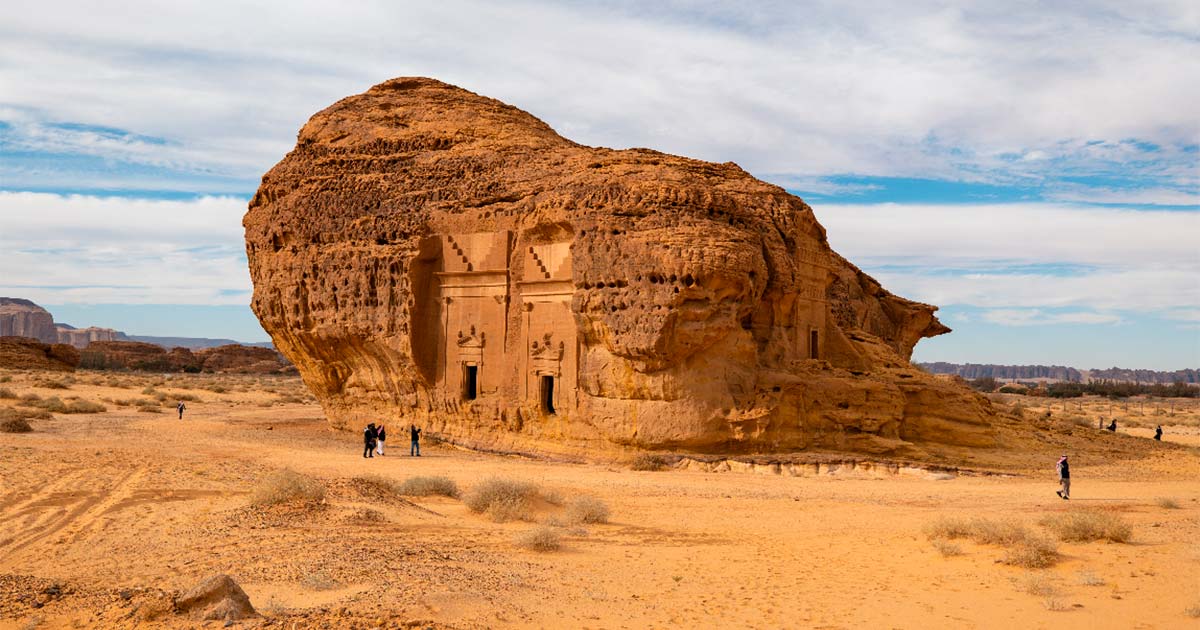The Marvel of Mada’in Saleh and the Enigmatic Nabataean People
The archaeological site of Mada’in Saleh, previously known as Hegra, is the most famous ancient site in Saudi Arabia. It is also the first archaeological site of Saudi Arabia to be included in the World Heritage List. It is surprising how little known this site is, considering UNESCO describes it as “an outstanding example of architectural accomplishment and hydraulic expertise”.
Mada’in Saleh was one of the southern outposts of the mysterious Nabataean people, the same people that built the magnificent city of Petra in Jordan, their ancient capital. Built between the 1st century BC and the 1st century AD, Mada’in Saleh is an architectural marvel and a testimony to the skill and craftsmanship of the Nabataean who, 2,000 years ago, carved more than 131 tombs into solid rock, complete with decoration, inscriptions, and water wells.
Nabataean Marvels: Mada'in Saleh's Architectural Splendor
The enigmatic Nabataeans were originally a nomadic tribe, but about 2,500 years ago, Nabataean settlements began to flourish. As well as their agricultural activities, they developed political systems, arts, engineering, stonemasonry, and demonstrated astonishing hydraulic expertise, including the construction of wells, cisterns, and aqueducts. These innovations stored water for prolonged periods of drought, and enabled them to prosper. They expanded their trading routes, creating more than 2,000 sites in total in the areas that today are Jordan, Syria and Saudi Arabia. Archaeologists still try to unravel the history of the Nabataeans, which in large remains unknown.

Qaṣr Al-Farīd meaning ‘the Lonely Castle’ is the largest tomb at the archaeological site. (Richard.hargas/CC BY-SA 4.0)
Today, you can see several large boulders rising out of the flat desert, and most of the structures seen were used as tombs, all of them cut into the surrounding sandstone rocks. The area has multiple quarries that the Nabataean masons are said to have used to cut and carve stone blocks. However, no buildings utilizing stone blocks have ever been found so it is unknown what exactly the quarries were used for. The mystery may lie below the sand of the desert, with monuments still waiting to be explored.
- Petra’s Saudi Arabian Sister City, Hegra, Opens to the Public
- The Qasr al-Farid, the Lonely Castle of the Nabataeans
Heart of Spiritual, Cultural Exchange
Mada’in Saleh served as a key point in trade and commerce along the Incense Route, which was an ancient network of trade routes connecting southern Arabia with the Mediterranean world. This route facilitated the trade of valuable commodities, such as frankincense and myrrh, which were highly sought after in the ancient world due to their religious significance in many ancient societies.
The Nabataeans, who inhabited Mada'in Saleh, controlled a significant portion of this route, allowing them to regulate and profit from the lucrative incense trade. This also gave them a socio-political power. Mada'in Saleh, became a melting pot of diverse cultures, where traders, travelers, and pilgrims from various regions interacted, shared ideas, and contributed to the vibrant cultural tapestry of the site.

Ancient tombs in Mada’in Saleh illuminated during the night. (vadim.nefedov/Adobe Stock) Principio del formulario
Deciphering the Inscriptions: the Secrets of Mada'in Saleh
There is very little information about Mada’in Saleh and whatever we know today comes from around fifty inscriptions found in the tombs and on the facades. One of these inscriptions (which is a Roman inscription) shows that Mada’in Saleh was inhabited for at least a century longer than what scholars previously thought. On the site there are also about 50 pre Nabataean inscriptions including some cave drawings.

Entrance to one of the Nabatean tombs in Mada’in Saleh, Saudi Arabia. (Abu Shar Namureh/CC BY-SA 4.0)
According to the Roman scholar Strabo, although the people were governed by a royal family, it is said that a strong spirit of democracy prevailed and that the workload was shared among the community. Like much of the ancient world, they worshipped a pantheon of deities, chief among them being the sun god Dushara and the goddess Allat.
The name Mada’in Saleh (“city of Salih”) is associated with a pre-Islamic prophet, Salih, of the tribe of Thamud, who is also mentioned in the Qur’an. His community is mentioned to be ‘wicked’ and because of that God destroyed them. Even today the remains of the ancient site are considered by Muslims to be cursed. Salih (or Saleh) is the equivalent of Salah in the Hebrew Bible.
O Salih! You have been among us as a figure of good hope and we wished for you to be our chief, till this, new thing which you have brought that we leave our gods and worship your God (Allah) alone! Do you now forbid us the worship of what our fathers have worshipped? But we are really in grave doubt as to that which you invite us to monotheism.
(CH 11:62 Quran).
- The Sophisticated Water Technologies of the Ancient Nabataeans
- Magnificent Gardens of Petra Discovered After 2,000 Years

Salih Inviting His People to See the She-Camel Illuminated collection of Stories of the Prophets. (Public Domain)
The tribe of Thamud is said to be descendants of a great-grandson of the Biblical Noah. However, the Thamud were said to have become very corrupt and materialistic and stopped believing in God. According to the account, this is when God sent prophet Salih to warn them that if they would continue in that way they would be destroyed.
"So the earthquakes seized them and they lay dead, prostrate in their homes. Then he (Salih) turned from them, and said: "O my people! I have indeed conveyed to you the Message of my Lord, and have given you good advice but you like not good advisers." (Ch 7:73-79 Quran)
The kingdom of the Nabataeans eventually declined with the shift in trade routes to Palmyra in Syria and the expansion of seaborne trade from the Arabian Peninsula to Egypt. Sometime during the 4th century AD, the Nabataeans finally abandoned their capital at Petra and migrated north.
Top image: Mada'in Saleh (Al-Ḥijr & Hegra) archaeological site near Al Ula, Saudi Arabia. Source: hyserb/Adobe Stock
By John Black
References
Harrigan, P. 2007. New Pieces of Mada’in Salih’s Puzzle. Saudi Aramco World . Available at: https://archive.aramcoworld.com/issue/200704/new.pieces.of.mada.in.salih.s.puzzle.htm
Hegra Archaeological Site (al-Hijr / Madā ͐ in Ṣāliḥ) Available at: https://whc.unesco.org/en/list/1293
Ibn Kathir. (n.d.) Story of Prophet Salih. Available at: https://www.islamawareness.net/Prophets/salih.html
Madain Saleh. Available at: https://unusualplaces.org/madain-saleh/#google_vignette


















Comments
Modern historians have much of the whole ancient Midian/Midyan (modern Arabic Mada’in) area wrong. Only with the historic movements of peoples in the 450s-500s into the Mideast from China and India, was the rise of the “Arab” populations. And even that word has been misused.
The Hebrew word “ereb” meaning dark, dark-skinned, and deliberately misused in translation of the bible with Elijah fleeing the Kingdom of Israel (from Jezebel) travelled down into Midian, where he was fed by the “crows.” Those “crows” were the dark-skinned Nabataeans of Petra and Mada’in Saleh (!).
The Nabataeans might be found historically in 586 BCE, but they were in existence as far back as 1207/1206 BCE of the biblical Exodus, when Moses, the Israelites, and the “mixed multitudes of people” left Egypt and stayed in the Wilderness of Zin and Midyan (of Petra) for 40 years, before the Israelties left to enter into Canaan, while these remnants stayed in the greater Midyan and Petra region.
It is absolutely known that the Kingdom of Kush once conquered by invitation the Upper Egyptian Nile region (“the black pharaohs”), pushed out, then later conquered by Egypt. These Kushites of Nubia, had their capital at “Napata” – from which the true name of these Nabataeans (Napata-eans) were those portions of enslaved Kushite blacks that went with Moses, settled in the greater Midyan and Petra region, and stayed there when the Israelites pulled out in 1167/1166 BCE. The Napabateans were Kushites – the biblical “erebs” of that time, and not the modern Asian-Indian (dark-skinned) peoples of the Goths, Vandals, etc of the 450s-550s who settled in Saudi Arabia, Egypt, and north Africa.
It is also Petra that is also wrongly worded as it is Pendragon or ibn dragon. Petra was the first Christian refugee kingdom, when the Christians fled the Roman invasion and conquest of the (Persian) Pharisee jewry occupation of Judah, and destroyed them. The Christians were in Petra and Mada’in Saleh in those 69/70 – 600s … and ending at the time of the rise of Muhammed, the (new) “Arabs,” and the Islamic religion.
The majority of historical constructions of Petra and Mada’in Saleh were in those times of the Israelites (1207/1206-1167/1166 BCE), Napataeans (1167/1166 BCE – 69/70 CE, Christian kingdom (69/70 – 600s CE), … then lastly with any remaining Arabs (600-xxxx CE). It was Muhammed was born and grew up in this Midyan (Mada’in) region, where the rise of Islam first was preached and founded.
Historians really need to get all their facts correct..
Mada'in is actually plural; it's "Cities of Saleh" (madinah is singular). How do I know? I visited once while living in Saudi for ten years.
I look at this an think that there is no way that was all varved away by hand, there had to have been some kind of explosive material used or something to bladt and good potion of the rock away before they start carving and sculptinjg.